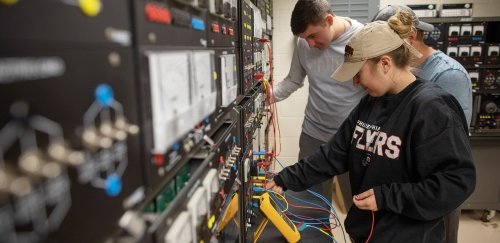
Electronics Engineering Technology
High technology components make up the computers, cell phones and other devices that are used daily. Electronics engineering technologists concentrate on applied design using current engineering practices and program management.
- Degrees & Offerings
-
- B.S.
- Location
-
- Bloomsburg
- Lock Haven
- Mansfield
- Program Contact
-
Program Coordinator, Professor of Electronics Engineering Technology
Commonwealth University’s bachelor of science degree program in Electronics Engineering Technology (EET) teaches students to work with the latest high-tech equipment and prepare for in-demand rewarding careers in industry.
The day-to-day problem-solvers in the electronics manufacturing industry, technologists differ from technicians, who specialize in assembly, trouble-shooting and repair. Engineering technologists identify and solve problems with a hands-on approach based on sound theoretical concepts. CU's curriculum reflects that practical approach. To prepare students for real-world careers, the 4.5-year program is structured so students serve a six-month paid apprenticeship. This unique arrangement means students pay tuition for only four years.
Course Delivery Format
Bloomsburg
Face-to-Face
Online
Hybrid
Lock Haven
Face-to-Face
Online
Hybrid
Mansfield
Face-to-Face
Online
Hybrid
Clearfield
Face-to-Face
Online
Hybrid
Courses and Curriculum
Our EET program is accredited by the Engineering Technology Accreditation Commission of ABET, which demonstrates a program’s commitment to providing its students with a quality education.
Degree Requirements Degree Works
Note: Degree requirements effective for enrolled students beginning Fall 2023. All enrolled students, including matriculating students prior to Fall 2023, can review their degree program requirements and track progress to degree completion with our degree audit and advisement tool, Degree Works.
Educational Objectives
The Electronics Engineering Technology program educational objectives (PEOs) are to produce
graduates that are prepared for:
- Career fields associated with the research, integration, programming, and application of technology to design, analyze, develop, manufacture, modify, operate, and maintain contemporary electrical and electronic products and systems.
- Career advancement and continuing professional development.
- Understanding the importance of communication in a technical environment, and the overall societal context within which their contributions take place.
Student Learning Outcomes
The Electronics Engineering Technology program student outcomes are:
- Ability to select and apply the knowledge, techniques, skills, and modern tools of the discipline to broadly-defined engineering technology activities
- Ability to select and apply a knowledge of mathematics, science, engineering, and technology to engineering technology problems that require the application of principles and applied procedures or methodologies
- Ability to conduct standard tests and measurements; to conduct, analyze, and interpret
experiments; and to apply experimental results to improve processes Ability to design systems, components, or processes for broadly-defined engineering technology problems appropriate to program educational objectives - Ability to function effectively as a member or leader on a technical team
- Ability to identify, analyze, and solve broadly-defined engineering technology problems
- Ability to apply written, oral, and graphical communication in both technical and nontechnical environments; and an ability to identify and use appropriate technical literature
- Understanding of the need for and an ability to engage in self-directed continuing professional development
- Understanding of and a commitment to address professional and ethical responsibilities including a respect for diversity
- Knowledge of the impact of engineering technology solutions in a societal and global context
- Commitment to quality, timeliness, and continuous improvement
Electronics Engineering Technology
Alumni
Where do our EET students get hired? Anywhere and everywhere. Because employers value a CU degree, and the person who earned it. Check out some of the (many) places where our alumni are employed.
- Geisinger Health System - PA
- Boeing Company - WA
- Valmet Inc. - PA
- Dentsply Sirona - PA
- Snyder Hoffman Associates - PA
- Compression Components and Services - PA
- Schneider Electric - PA
- GES Automation - PA
- TAIT Towers - PA
- Retlif Testing Lab - PA
- Raytheon - AZ
- Grantek Systems Integration - PA
- Sargent and Lundy - DE
- Lockheed Martin - PA
- AECOM - VA
- JMP Solutions - NJ
- Aerospace Corporation - MD
- PPL Electric Utilities - PA
- Insteel Wire Products - NC
Documents
Many jurisdictions require engineers to be licensed in order to practice. Licensure also provides additional career options and opportunities such as starting your own company or working as a consultant.
How Do I Get Licensed?
Step 1: Graduate
- Graduate with an ABET accredited B.S. degree in Engineering or Engineering Technology
Step 2: FE (Fundamentals of Engineering) Exam
- Most engineering students take this exam right before or soon after graduation
- Once you pass the FE exam, you are classified as an Engineer-in-Training (EIT)
- Also known as Engineering Intern (EI)
Step 3: Work Experience
- Four (4) or more years of progressive experience in engineering work earned after the issuance of
the EIT certificate - Experience shall be under the supervision of a P.E. or similarly qualified individual
- You may obtain one year of experience credit for each post-baccalaureate degree (not to exceed
two years)- Shall be full time student in the same engineering field
Step 4: PE Exam
- Principles and Practice of Engineering
- After completing the required work experience, you can take this second exam in the licensure process
Step 5: Now you are a Professional Engineer!
- John Smith, P.E.
What is Fundamentals of Engineering (FE) Exam?
- Eight hour long exam: Two four hour sessions
- Closed book (Reference material supplied)
- AM session
- General exam common to all disciplines
- 120 multiple choice questions
- Mathematics, Probability/Statistics, Chemistry, Computers, Ethics/Business Practice, Engineering Economics
- Engineering Mechanics (Statics/Dynamics), Strength of Materials, Material Properties, Fluid Mechanics, Electricity and Magnetism, Thermodynamics
- PM session
- Discipline specific (e.g., Electrical Engineering)
- 60 multiple choice questions
- Circuits, Electronics, Power, Electromagnetics, Control Systems, Communications, Signal Processing, Digital Systems, Computer Systems
What is Principles and Practice of Engineering (PE) Exam?
- Exam length: 8 hours (Two 4 hour sessions)
- 40 multiple choice questions per session
- Open book exam
- Hardcopy of your own reference material is also allowed
- Electrical and Computer Engineering
- Breadth Exam (AM): This exam contains questions from a broad area of electrical and computer engineering
- Basic electrical engineering, Electronics, Control and Communication Systems, and Power
- Depth Exam (PM): This exam focuses on a single area of practice in electrical and computer engineering
- Computers
- Power
- Electronics, Controls and Communications
- Breadth Exam (AM): This exam contains questions from a broad area of electrical and computer engineering
Additional Information
EET Industry Influence
Strong Curriculum
EET Industry Influence
Reflecting CU's close relationship with the electronics industry, the curriculum has been shaped with input from industry leaders, who serve on the program's advisory board. These leaders include representatives from Pennsylvania high-tech firms such as:
- L3 Communications, Williamsport
- Geisinger Health System, Danville
- Talen Energy, Berwick
- Thermal Product Solutions, New Columbia
- ISS Solutions, Danville
- Grantek Systems Integration, Allentown
- Martz Technologies, Berwick
- Girton Manufacturing, Millville
Build Your Future in Electronics
Careers
Our students are known for their grit and determination. In the EET program, perseverance is key. Even students who struggle academically during their first year are able to utilize the supports available, graduate, and enjoy a great career.
Potential Job Opportunities
- Professional Engineer
- Project Manager
- Manufacturing Engineer
Top Skills Employers are Looking For
- Project Management
- LabVIEW, Matlab/Simulink, RSLogix PLC programming
- Circuit simulation software (LTspice, Multisim)
- Circuit board layout software (Ultiboard)
- CAD (SolidWorks)
Program Contacts
Applying to This Program
Apply
-
Application Process
Review the step-by-step process whether you're a first-year student, transferring to CU, or more.
-
Apply Now
By starting your application, you gain access to your personalized application portal to view your progress.
-
Scholarships
As the largest comprehensive university in north central and northeastern Pennsylvania, CommonwealthU works hard to provide a world-class education that consistently rates among the best values in the nation.
Explore More
-
Explore Commonwealth University
There's no better way to learn more than to experience Commonwealth University for yourself! Set up a campus tour or connect with us virtually.
-
Connect with Your Admissions Counselor
Applying to college is a big step. You have questions, and we have answers!
-
Understanding Financial Aid
Financial Aid can be a complex topic. Our Financial Aid team is here to tell you what you need to know and help you navigate the financial aid process.

